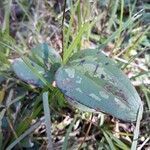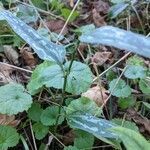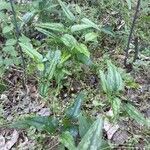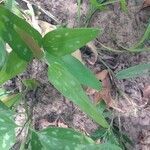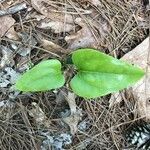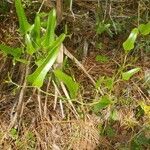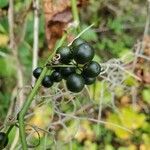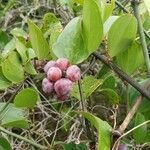Vines; rhizomes tuberous, woody, or stoloniferous. Stems perennial, climbing, often zigzag distally, branched, terete to 4-angled, stout, to 5+ m × 5 mm, woody, glabrous or infrequently with stellate trichomes; prickles often absent distally, tips black, flattened, broad-based, stout, 4–9 mm, rigid. Leaves evergreen, ± evenly dispersed; petiole 0.7–1.5 cm; blade pale green, often with white blotches, drying to uniform tan, thickish, broadly ovate to lanceolate-ovate or hastate to pandurate, with 3(–5) ± prominent veins, 3–10 × 2.5–9 cm, not glaucous, glabrous or minutely pubescent abaxially, base cordate to truncate, frequently lobed; margins entire to remotely spinose-ciliate, thickened by ribbed, cartilaginous band, often revolute and appearing as prominent vein parallel to margins, apex rounded to short-apiculate. Umbels few to numerous, axillary to leaves, 10–15+-flowered, moderately dense; peduncle 1.5–6+ cm. Flowers: perianth pale green; tepals 3–4.5 mm; anthers shorter than to ± equaling filaments; ovule 1 per locule; pedicel 0.8–1.2 cm. Berries black, ovoid to spherical, 6–8 mm, shiny to dull, sometimes glaucous. 2n = 32.
More
Slender woody vine; stems usually 4-angled, diffusely branched and often climbing high, armed with large, stout, flattened prickles especially on the angles, or distally unarmed; lvs subcoriaceous and ± persistent, ovate to deltoid or hastate, 4–8 cm, green beneath, conspicuously thickened at the entire or spinulose margins; veinlets prominent; peduncles flattened, much longer than the subtending petiole; fr black, 6–8 mm, 1-seeded; 2n=32. Dry woods, thickets, abandoned fields, and roadsides; s. Md. to Mo. and se. Kans., s. to Fla. and Mex. May–July.
A slightly woody plant. It is a climbing vine that keeps growing from year to year. The stems are four sided. The branches have long green tendrils. The leaves are triangle shaped. They are alternate and fall off during the year. They are 5-10 cm long. There can be teeth along the edge. The vine can be separately male or female. These are in dense round clusters. They are greenish-white. The fruit are black and small. They are 5-10 mm across. The seeds are very small and brown.
Dry to moist soils, sand dunes, fields, clearings and thickets. Well-drained to wet areas in woods, fields, thickets, hedgerows, floodplain forests, growing in full to partial sun; at elevations from sea level to 1,000 metres.
The fruit can be eaten raw or slightly cooked. The young shoots are cooked with other vegetables. The tuberous roots can be used in jellies and drinks. They can also be dried, thickened and used as flour.
